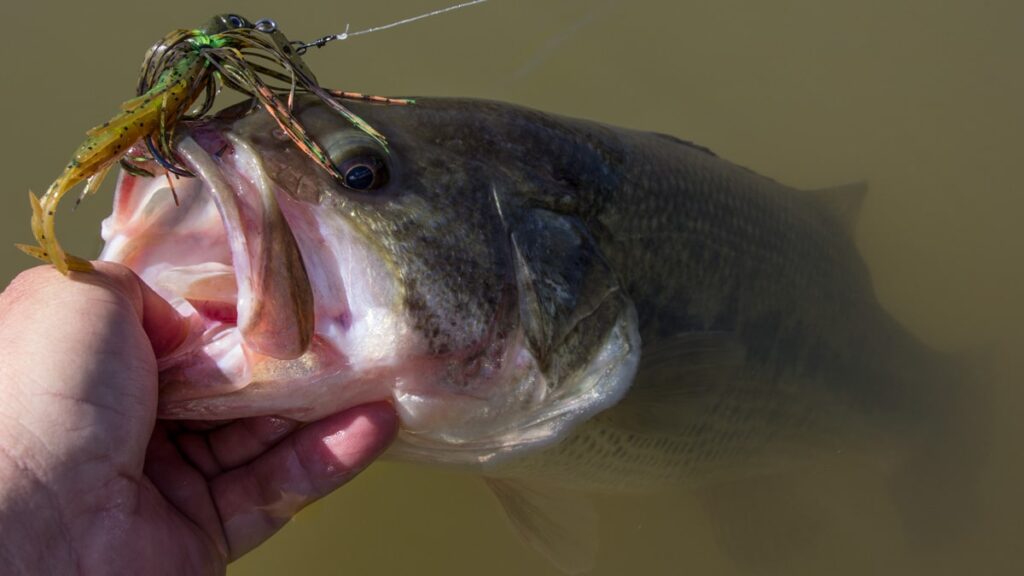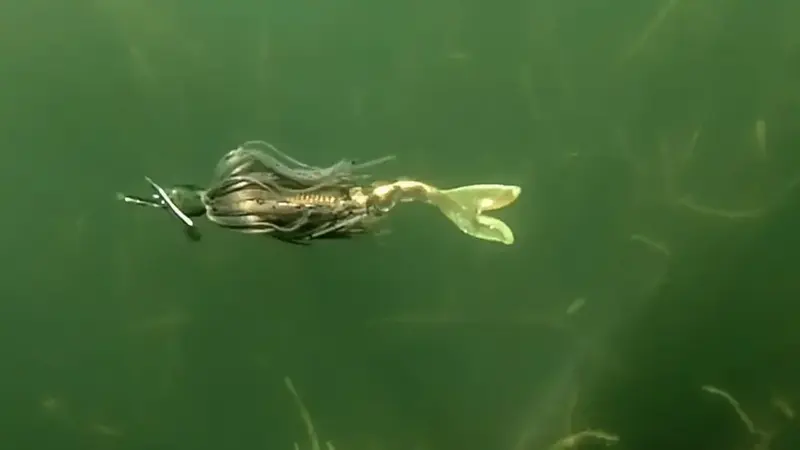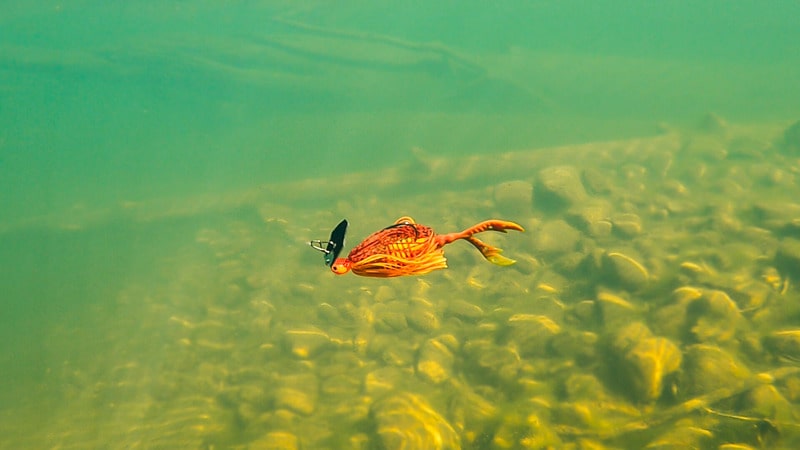When to Use a Chatterbait for Bass Fishing?

In the last decade or so, chatterbaits have burst on the scene and started winning countless tournements.
Often referred to as a bladed jig, this lure has quickly risen to the top of every angler’s best lures lists.
But no lure is always the best option. You need to know when to use a chatterbait in order to maximize your success with it.
What Time of Year to Use a Chatterbait?
Chatterbaits can certainly catch bass throughout all types of the year. Other than the wintertime, I fish chatterbaits year round.
And even during those winter months, you can still have great success with a chatterbait, it is just that there are better options out there.
With that being said, there are two types of year when chatterbaits out perform almost any other lure.
Pre-spawn
I think that chatterbaits are my favorite overall pre-spawn bass lure. Everything about them perfectly appeals to early spring bass.
The blade puts off tons of thump and vibration, making it easy for these hungry bass to find it.
A chatterbait is also made to be fished a bit slower. The slower retrieves are perfect for the pre-spawn because although bass are hungry, the water temperatures are still quite cold.
Meaning bass prefer a bit slower moving targets. And finally, something about skirted baits just seem to catch more bass during the spring.
Once bass move out of their deep, wintering areas, a chatterbait is hard to beat.
Also Read: Spring Chatterbait Fishing
Early Fall
The aggressive vibration and frequency of a chatterbait makes bass feral in the water.
Once the fall begins rolling in, bass are progressively becoming more aggressive and aren’t holding as close to structures like wood, rocks, and grass.
These bass are an the hunt for an easy meal. The chatterbait is incredibly easy for bass to hone in on and doesn’t move too quickly for the to hunt down.
During the early fall, there is still lots of vegetation. Target grass lines and patches. Bass cruise this vegetation looking for easy targets.
Muddy Water
The vibrating blade of a chatterbait creates tons of vibration, and even a little bit of flash.
This blade also creates so much resistance that you are forced to retrieve the bait slowly.
When fishing muddy water, you need to use lures that are easy for bass to feel and hear because their sight is mostly useless.
While reeling in the vibrating jig, you will be able to feel it all the way through your rod tip. Bass can feel the same thing in the water.
Chatterbaits aren’t necessarily the most realistic profile, but you don’t need to worry about this when the water is muddy.
I also like to modify my chatterbaits a bit to give them even more vibration in this water.
Overcast Days

Really all bladed baits work better on overcast, cloudy days. The low light conditions reduce visibility in the water, making flash and vibration more important.
You have certainly heard that overcast days are a great time to use spinnerbaits, but the same thing is true about bladed jigs.
Another reason why they are more effective in overcast conditions is that on these cloudy days, bass will not hold super tightly to cover.
The sun is not beating down on the water, so bass don’t have to hide in the shade of grass or structure.
Instead, they will drift away from cover and cruise the open water in search of prey.
Chatterbaits are obviously not weedless lures, so they work better when fished in open water.
Overcast weather makes vibration much more crucial and makes bass actively search for bait.
Morning and Evening Hours

This rule follows the same logic as overcast days. The morning and evening hours of the day are much lower light scenarios.
Meaning that water visibility will be lowered and the chatterbait will look more natural and enticing to bass.
Wind

Generally speaking, this rule also follows the same logic. The wind creates lots of chop on the water which scatters and breaks up the sunlight entering the water.
This scattered light distorts the visibility and makes it a bit harder for bass to see your lure clearly.
Aside from the visibility factor, the wind also stirs up the water and gets baitfish disoriented, out in the open, and quickly darting around.
The chatterbait is a perfect way to imitate a few baitfish that are trying to find safer waters.
Best Water Depth to Fish a Chatterbait
In my eyes, bladed jigs are primarily a shallow water lure. Because of the angle and vibration of the blade, chatterbaits will rise to the surface very quickly.
If you get a very heavy chatterbait and retrieve it super slowly, you can fish deeper, 12-15 ft water.
But I believe that there are better lure options once you get passed 10 ft of water depth.
I really focus on the 3-7 ft depth range. I will fish closer to the 10 ft range during the pre-spawn when bass are a bit deeper.
But this lure is made for shallower water.
Grass

Now when I say “grass”, I don’t mean weeds or thick vegetation. I am talking about actual grass such as hydrilla or milfoil.
The exposed hook will get stuck in the thick weeds or algae that is found in lots of ponds.
But if you have access to real grass, tie on a chatterbait. The bait will inevitably get caught on some vegetation.
But when this happens, just snap your rod and the chatterbait will pop right out of it.
This often gets trailing bass to engulf the bait as a reaction strike.
Rocks

Rocks are probably my favorite place to use a chatterbait. The angled blade deflects off off the rocks and crawls the lure over them.
Chatterbaits make an incredible crawfish imitation in stained to muddy water.
Slow rolling the chatterbait right over the rocks looks and feels exactly like a crawfish to the bass.
I said earlier that I rarely use chatterbaits during the winter. But one exception to this rule is on warm winter days.
During these winter warm fronts, bass will move up into shallow rocks. They do this because rocks absorb lots of light and warmth from the sun.
So bass target these rocks to gets some quick and easy warmth during the winter.
Chatterbaits are always my first option when targeting these bass. I can slowly crawl the chatterbait over the rocks and cover lots of water.
When bass are holding to the rocks, chatterbaits are a great lure option.
When to Use Action Trailers on a Chatterbait?
“Action trailers” refer to trailer baits that have lots of swimming action such as paddle tail swimbaits, craw styles, or curl tail grubs.
These trailers add visual action and vibration to the chatterbait. These trailers are better for really stained to muddy water.
These trailers will slow down the chatterbait and give it some extra vibration.
Both these things make it easier for bass to find and hunt down the lure in low visibility water.
When to Use Actionless Trailers on a Chatterbait?
“Actionless trailers” are those like a fluke or split tail trailer that don’t have any action or vibration on their own.
Because of the shaking and side to side motion of the bladed jig head, these trailers do move and undulate in the water.
However, they don’t create resistance or vibration in the water. These trailers are best for stained to clear water.
In my opinion, the visual appeal of an actionless trailer is far superior. It looks much more natural and enticing.
You can also retrieve the lure much faster since these baits don’t have any resistance. Speed and realism are the keys to clear water.
Gear for Fishing a Chatterbait
Key Points
- Chatterbait Versatility: Chatterbaits, or bladed jigs, have become a staple in the angler’s toolkit, consistently delivering success in tournaments. Despite being effective year-round, understanding the optimal conditions enhances their effectiveness.
- Seasonal Success: Chatterbaits excel during the pre-spawn and early fall. The slow, thumping vibrations appeal to hungry bass in the colder pre-spawn months, while the aggressive nature of chatterbaits makes them a go-to choice as bass become more active in early fall.
- Muddy Water Advantage: The vibrating blade and slow retrieval of chatterbaits make them ideal for fishing in muddy water. The added vibration helps bass locate the lure, compensating for reduced visibility.
- Overcast Conditions: Chatterbaits shine on overcast days due to lower light conditions, making flash and vibration crucial. On such days, bass are more likely to roam open waters, increasing the chances of a successful catch.
- Morning and Evening Success: Similar to overcast days, low-light scenarios during morning and evening hours enhance the chatterbait’s appeal, making it appear more natural and enticing to bass.
- Wind and Water Disturbance: Windy conditions create choppy water, reducing visibility and making it harder for bass to see lures clearly. The chatterbait’s ability to imitate disoriented baitfish in disturbed water makes it an effective choice in windy conditions.
- Shallow Water Preference: Chatterbaits are primarily suited for shallow waters, with the blade’s angle causing them to rise quickly to the surface. While they can be fished in deeper waters with a slow retrieve, the 3-7 ft depth range is optimal.
- Targeting Grass and Rocks: Chatterbaits excel when fished near real grass, such as hydrilla or milfoil, and rocky areas. The exposed hook can navigate through grass, and the angled blade deflects off rocks, making it an excellent choice for imitating crawfish in stained to muddy water.
- Trailer Selection: Action trailers, with swimming action, are suitable for stained to muddy water, adding visual appeal and vibration. Actionless trailers, like flukes or split tails, are better for stained to clear water, providing a more natural appearance and allowing for faster retrieval.
FAQ
Q1: Can chatterbaits be used during the winter months? A: While chatterbaits can still yield success in winter, there are better options available. Warmer days during winter fronts might prompt bass to move into shallow rocks, making chatterbaits effective in these conditions.
Q2: What makes chatterbaits effective in muddy water? A: The vibrating blade creates significant vibration and resistance, making it easy for bass to feel and hear the lure in low-visibility muddy water.
Q3: Are chatterbaits weedless? A: Chatterbaits are not weedless, and they can get caught in thick vegetation. However, they work well in real grass, and a quick snap of the rod can release the bait when it gets entangled.
Q4: When is the best time to use action trailers on a chatterbait? A: Action trailers, with swimming action, are ideal for stained to muddy water, enhancing the chatterbait’s visibility and vibration in low-visibility conditions.
Q5: Why use actionless trailers on a chatterbait? A: Actionless trailers, like flukes or split tails, are better suited for stained to clear water, providing a more natural look and allowing for faster retrieval due to the absence of resistance
Reeling this In
In the last decade, chatterbaits have revolutionized bass fishing, earning a well-deserved spot in every angler’s arsenal.
Their adaptability shines during the pre-spawn, early fall, and in specific conditions like muddy water and overcast days.
With a preference for shallow waters around real grass and rocks, chatterbaits offer a versatile and effective option.
Whether equipped with action or actionless trailers, these lures cater to different scenarios.
While not a one-size-fits-all solution, understanding when and where to use chatterbaits ensures they remain a potent tool in an angler’s kit, adding excitement and success to every fishing expedition.






